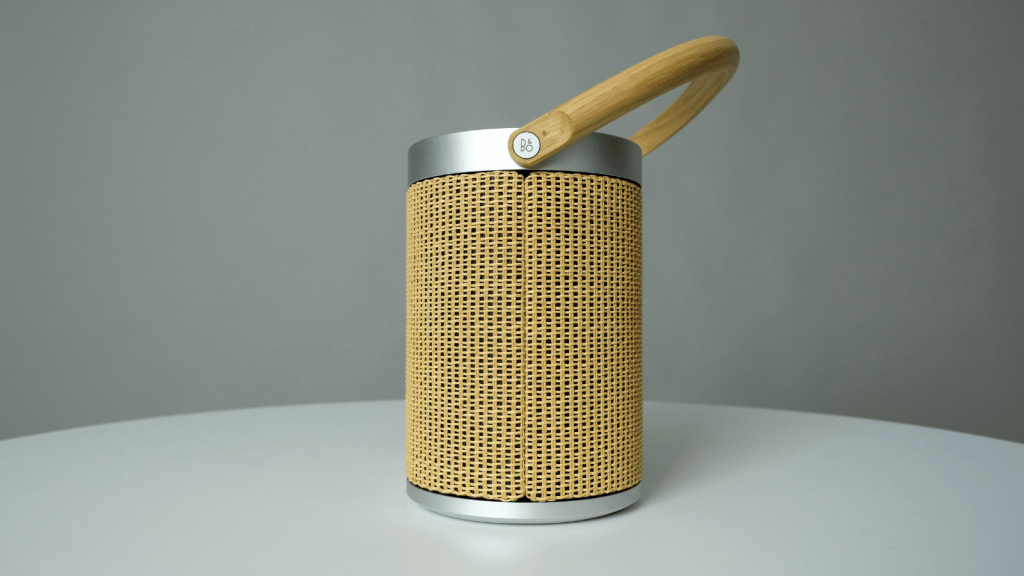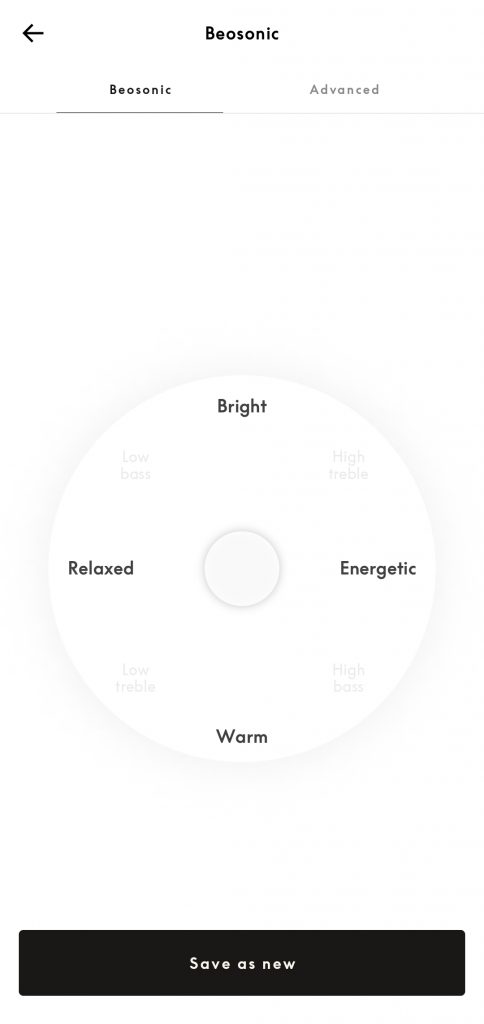If all you want is a box that makes noise, this isn't the speaker for you. It's aimed at the folks who want a capable speaker that isn't an eyesore in their meticulously designed living room. It isn't what most people would call 'affordable' but the Beosound A5 from Bang & Olufsen does a lot to justify its lofty price. Whether it does enough for you is a question only you can answer.
-
Design
-
Audio output
-
Connectivity
-
Set-up
-
Value
Several things became immediately obvious when the Beosound A5 from Bang & Olufsen first showed up at Stuff HQ. The first was that it was nearly lunchtime because let’s face it, the Nordic Weave model featured here wouldn’t look out of place on a blanket in a park along with some sandwiches.
Once we got over that and took a closer look at the anodised aluminium plates, oak wood handle, and paper fibre weave covers, we were reminded of Bang & Olufsen’s esteemed heritage – and that this speaker was probably a pricey one.
The Danish audio company has been around for nearly 100 years, making high-end audio products and the Beosound A5 is its latest portable wireless speaker, starting at R26,000. The price might sound ridiculous at first but after considering its performance, design, and the company responsible, things start to make a lot more sense.
Make a statement without saying a word
We’ll be honest, we couldn’t see past the picnic basket resemblance for the first few days of reviewing the Beosound A5 but it’s grown on us since then. It’s also available with anthracite plates and a dark oak finish. That one’s slightly more expensive but it probably won’t matter to you if you’re already considering a B&O product.
As ever, B&O has crafted premium materials into an exquisitely designed product that’s worth putting on show before you’ve even switched it on – for some people out there, at least. The materials, build quality, and attention to detail are a few of the design aspects that make the Beosound A5 stand out. They’re also why we’d hesitate to call this a ‘portable’ speaker, weighing just shy of 4kg. The solid oak handle carries the weight with no problem but this isn’t really a speaker for packing into a bag on a hike.
As far as physical features go, B&O has kept it minimal. The control buttons, recessed slightly into the top plate, provide good tactile feedback but are a little tough to see in low light. It’s not a big deal because you’ll probably be using the companion app most of the time anyway. The buttons give you control over power, Bluetooth connection, volume, playback, and four ‘favourite’ buttons that you can customise.
Between the buttons, you’ll find a Qi wireless charging pad. Using this to keep your smartphone going will take a chunk out of the A5’s 12-hour battery life but if you keep it close to a power source or leave it plugged in, that won’t be a problem.
Packed with features, not sandwiches
In fact, we’d recommend you keep it plugged in whenever possible. Its fantastic audio performance is enhanced by an intelligent room compensation feature that plays a tone and then uses the built-in microphones to work out the acoustic signature of the room to cancel out any resonant frequencies. But it only works when plugged in and manually told to. This isn’t the only speaker to use a feature like this but it’s among the best in the game to do so.
Before you can calibrate the speaker, however, you’ll need to download the Bang & Olufsen app. It offers a broad level of control including B&O’s signature Beosonic EQ, support for linking your Deezer account if you really want to, and access to connection settings. It’s also where you’ll manage your other B&O devices in your Beolink Multiroom setup or customise the four ‘favourite’ buttons to play a radio station or playlist of your choice.
Wi-Fi 6 and Bluetooth 5.3 handle wireless connectivity options. We’d recommend sticking to a Wi-Fi connection wherever possible as this will offer the most control and is how you’ll stream music to the speaker, either with AirPlay, Spotify Connect, or Chromecast. Surprisingly for a high-end speaker, only SBC and AAC Bluetooth codecs are supported. We can’t say we missed high-res codec support streaming from Spotify, but it feels like an oversight when you’re paying this much.
Speaking of wireless features, while the A5 does have microphones and is compatible with a smart home setup and virtual assistant, your voice commands will need to be directed at your smartphone, there’s no support built-in.
How does this Beo sound?
Setting up and using the B&O app with the Beosound A5 was straightforward. We found the app to be a little laggy on our S20 Ultra while jumping between settings pages. It was, at most, a little odd and switching to a newer device helped somewhat. After the initial setup, you probably won’t be jumping between settings pages too often, B&O have placed the frequently used functions upfront.
The Beosonic EQ is one such function and a refreshingly different approach to personalising your sound. We stuck with the ‘Optimal’ sound mode during our tests although you’re presented with a few presets to choose from or the option to create and save your own.
Another important note, we’d recommend disabling the ‘Loudness’ toggle in the B&O app. It’s on by default and is supposed to boost deep bass and high treble when listening at low volumes. But the A5 isn’t short on bass even at low volumes and most people will be happy with the sound sans boost.
Tied into the sound modes is a toggle for directivity. The Beosound A5 features four Class-D amps that distribute its 280W total power between four drivers – a 13cm front-facing woofer, a 2cm front-facing tweeter, and two 5cm full-range drivers on the rear corners. These four drivers and their placement allow toggling between a narrow and omnidirectional sound dispersion.
We found the narrow, front-directed mode provided the best listening quality for indoor use, especially if you’re listening critically, whereas the omnidirectional mode is better suited for large spaces or outdoor listening.
Compensating for something?
Finally, we get to the Beosound A5’s sound performance. We’ll come right out and say this is one of the best portable wireless speakers we’ve had the pleasure of listening to. We were wonderfully surprised at just how big it could seem, effortlessly filling our relatively small room with its rich, full-bodied sound.
We mentioned bass earlier but it’s worth mentioning again. The A5 handles the low-frequency range with authority providing a clean, tight bass response that was never overbearing – not even during Hok-man Yim’s Poem of Chinese Drum.
There was one occasion when we found some distortion at the low end while we had it outside and were fiddling with the loudness toggle. The volume was nearly maxed (attempt with caution, it gets loud) when the bass response started to clip a little in Chase and Status’ bass-heavy Baddadan. In most cases and under practical listening conditions, this shouldn’t be an issue.
Similar poise and clarity are present across the rest of the frequency range. The delicate details of Yosi Horikawa’s Fluid were conveyed with airy confidence while Grace Jone’s vocals in Nightclubbing never seemed recessed, as they often are in less capable products.
Regardless of the genre we played, the Beosound A5 impressed us with its neutral tonality and made for a thoroughly enjoyable listening experience.
Bang & Olufsen Beosound A5 verdict
If you’re trying to find a good home for your spare R30k and need a wireless speaker for carrying around the house or entertaining guests on your patio…Get this one. It’s that simple. If you’re worried about people flinging basket jokes, go for the dark oak model.
Yes, it’s expensive, but B&O have still managed to make the Beosound A5 seem worth it. The pool of people who might find it appealing is admittedly rather small, mostly thanks to its price tag. But if you can stomach it, the Beosound A5 is one of the best-sounding battery-powered wireless speakers we’ve tried, with a fantastic build quality and robust feature set to boot.
You can find better value for your money elsewhere if all you care about is audio quality (you could also easily spend five times this amount), but that’s not what B&O is about. One of its key principles is longevity and the A5’s modular design together with B&O’s Mozart platform means replacing faulty parts or upgrading the streaming capabilities won’t require you to buy a whole new speaker every few years. But if you didn’t bat an eye at this price, you’ll probably buy a new one anyway.












